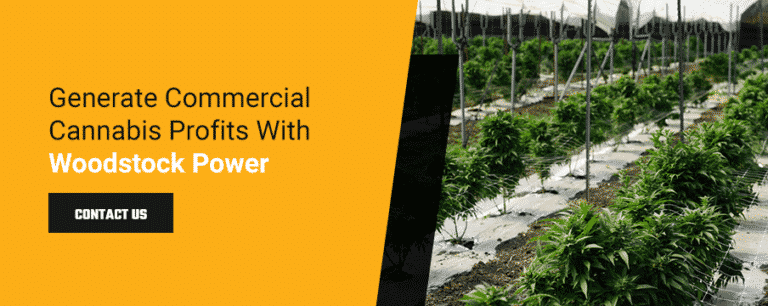Setting Up a Commercial Grow Room
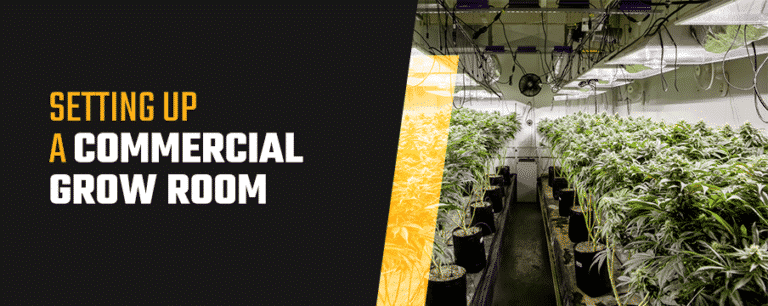
The legalization of cannabis in 33 states and D.C. means that there are more opportunities than ever in the cannabis industry. Starting your own grow operation can be a smart and lucrative move, but only if you know what you’re doing before you get started. In almost every situation, the best way to grow cannabis is in a controlled, indoor environment. Setting up a commercial grow room requires a methodical approach and a thorough understanding of the necessary equipment if you want to recoup your investment and turn a healthy profit.
What to Know Before Starting a Commercial Grow Room
Starting a grow operation isn’t as simple as signing a lease and putting plants in pots. The first thing you’ll have to do is apply for a grow license. The laws in each state are different, and many states have caps on the number of licenses available — so you’ll be facing some stiff competition in your application. Here are three things you need to do before applying.
1. Consult a Lawyer
Unless you are a legal expert yourself, you’ll need to consult a lawyer who can guide you through the laws affecting cannabis in your state. As cannabis is still illegal at the federal level, it’s essential to remain compliant with all state-level laws. You can find local cannabis lawyers using the database from the National Organization for Reforming Marijuana Laws (NORML).
2. Create a Development Team
A commercial-scale grow operation needs more than just you and your expertise. The more highly-qualified individuals on your team, the greater your chance of being approved by your state. Consider recruiting:
- Physicians
- Engineers
- Horticulturists
- Administrators
- Security managers
- Operations managers
You don’t necessarily need all of these roles filled to run an efficient operation, but it’s important to at least consider them as you create your business plan.
3. Find a Facility
The facility you choose will have a huge impact on how much your commercial grow room setup costs. Are you going to rent or buy the facility? How much square footage will you be growing in? How many rooms are included? How will you ensure the level of security required by law? Finding the right facility and ensuring it abides by all zoning laws can be complicated, but once you settle on an appropriate building, you can focus on your setup.
Example Costs of Setting Up a Commercial Grow Room
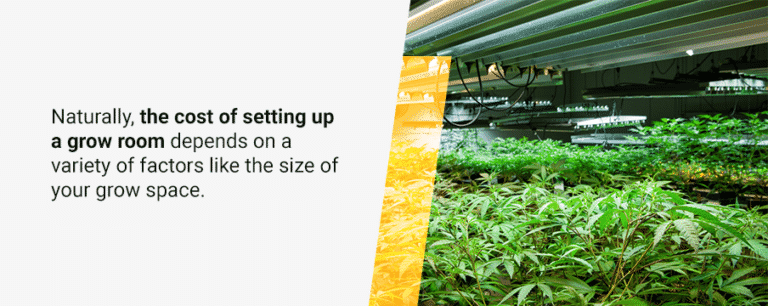
Naturally, the cost of setting up a grow room depends on a variety of factors like the size of your grow space. If we are assuming the grow room is housed in a 7,700-square-foot warehouse and holds 1,000 plants, the initial costs break down like this:
- Warehouse rent: $50,000
- Build-out and improvements: $60,000
- Growing equipment: $150,000
- Lighting: $120,000
- Security and alarm system: $45,000
- Legal fees and licensing: $55,000
- Direct costs before profit: $200,000
- Administrative expenses: $50,000
- Additional expenses including salaries: $100,000
The total initial investment for commercial cannabis growers using an indoor setup is about $830,000. With the additional costs such as electricity, water, labor and taxes, you’re looking at about $750,000 in direct costs per year. If you sell around 1,400 pounds of cannabis each year, you could be looking at a gross profit of about $1,000,000 annually.
What You Will Need to Set Up Your Own Grow Room for Success
To turn a profit from your investment, you need to keep seven essential elements in mind. Without consideration of these needs, you’ll end up with a sub-par crop and sub-par profits.
1. Lighting System
The need for lighting systems is both a drawback and advantage for indoor commercial growing. Outdoor grow operations rely on free sunlight, which greatly reduces energy costs. However, sun-grown cannabis is typically of lower quality and significantly impacted by weather factors out of the grower’s control.
Indoor growing with a lighting system allows you to consistently control the light cycle your plants receive regardless of what sunlight and weather are doing outside. For example, outdoor grows in winter receive less and less sunlight as the days grow shorter, reducing both yield and quality. By growing indoors, you extend your growing season to year-round and receive consistent yields.
There are many choices of grow lights, with high-intensity discharge (HID) and LED lights being some of the most popular. While HID lights are extremely powerful and can be used in combination with reflectors to produce even more usable light for your plants, they run very hot. The larger your commercial grow room, the more lights you need and the more temperature control you have to pay for. If you set up HID lighting incorrectly, you also run the risk of burning your plants and damaging your end yield.
LEDs offer a cooler solution, providing as much light as HIDs without the same electricity drain and heat. LEDs are more expensive than HIDs, but you’ll quickly recover the cost difference after just a few electric bills.
2. Climate Control
There are multiple elements of climate control that your grow room setup must address. Temperature is the most obvious, with your lighting system producing a significant amount of heat no matter what light type you choose. Resist the urge to get an over-sized AC unit, as it will cycle very quickly, leading to unwanted fluctuations in temperature that destabilize your carefully planned environment. A properly sized AC unit will run on longer cycles for better stability.
Humidity is the next consideration. Plants only use a tiny percentage of the water they receive, with the rest of it being released back into the air via transpiration. Most of the water you provide your plants ends up in the air, creating a need for multiple commercial dehumidifiers. Your dehumidifiers should be capable of removing the same amount of water given to the plants each day.
The third element of climate control is air movement. Free-flowing air is important in recreating optimal growth conditions in nature, strengthening plant stems and helping to distribute CO2 through the environment for better growth. It also prevents humidity from building up around the leaves, helping keep mold at bay.
3. Irrigation System
The larger your commercial grow room is, the less practical it becomes to have humans doing the watering. An irrigation system will save you money in the long run by delivering exactly the right amount of water each time and freeing up your employees to perform more important tasks. Uniform watering also results in more consistent quality and yield, allowing you to eliminate watering as a factor when you’re looking for ways to improve your crop.
4. Consumables
Consumables include the plants themselves, your growing medium, water and fertilizer. Plants and fertilizer have the widest range of potential costs and are not areas where you want to try and cut corners. One way to save on plants is to start from seeds rather than plants that have already sprouted. This will take longer, but can significantly reduce your upfront costs. You can also consider starting some from seed and some from plants to lower your cost somewhat while getting to your first harvest faster.
If you are growing in soil rather than using a hydroponics system, you’ll need to consider the type and amount of soil necessary for your grow operation. You can choose an all-in-one cannabis-specific soil for ease, but it will be more expensive than purchasing soil and fertilizer separately. On the other hand, the convenience of pre-mixed soil allows you to free up one or more employees for other critical work.
Fertilizer, your plant food, plays a significant role in the quality of your end product. Fertilizer made to the unique specifications of cannabis almost always has a huge markup when you purchase it. However, you can eliminate that additional cost by making your own large-batch fertilizer.
5. Security System
Security is serious business when it comes to growing commercial cannabis. To apply for a grower/processor license in Pennsylvania, you have to be able to prove your ability to “maintain effective security and control to prevent diversion, abuse or other illegal conduct.” While PA’s security provision is vaguer than those in other states, you don’t want to be caught with a less-than-robust system for tracking your crop and the people who handle it.
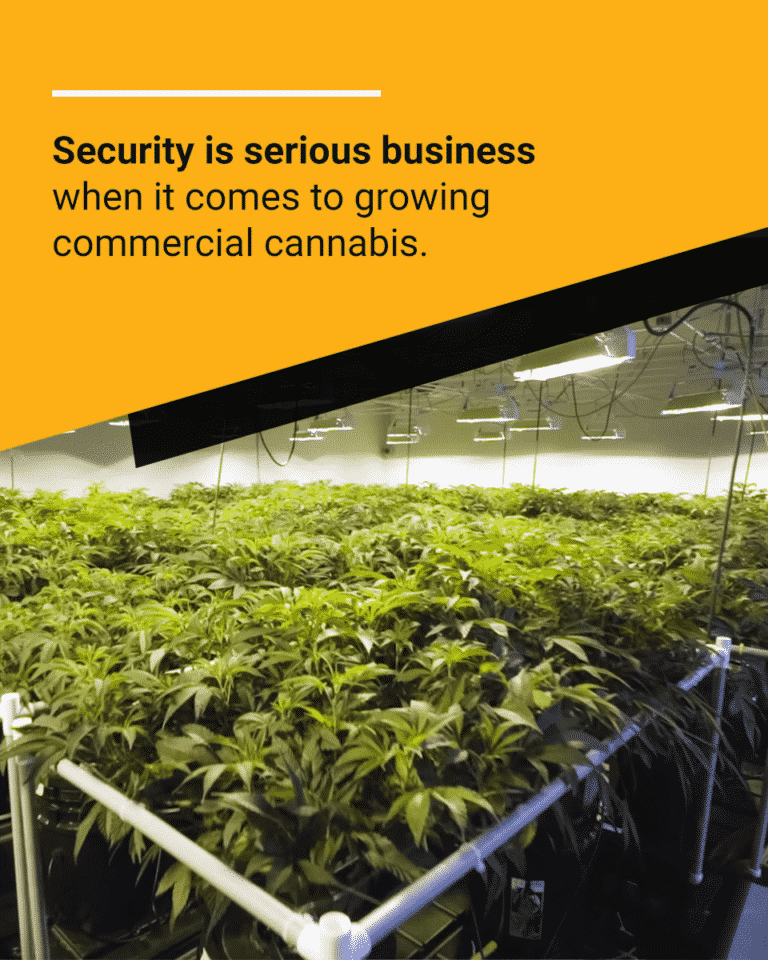
Your security system should include video surveillance, individual authentication of employees (such as through fingerprint scanners or card keys) and an alarm system to alert you immediately in case your facility is breached. While a comprehensive security system is one of the bigger costs of a commercial grow room setup, you don’t want to endanger your business by being on the wrong end of a compliance audit.
6. Pest Control
Pests are an unfortunate part of growing any commercial crop, and although the issue is less pronounced when growing indoors, you still need a solid strategy to defend your plants from damage. If you use pesticides, you must be careful to use those specifically approved for cannabis growth in your state. There are a number of pesticides and fungicides that are only allowed prior to final transport, for example.
One way to keep bugs away from your grow operation is to install weather-stripping. Not only does it seal up entrances for pests, but it also increases the energy efficiency of your setup.
It’s a good idea to come up with an integrated pest management (IPM) plan. Your IPM will help you identify, manage and eliminate pests efficiently. The goal of this formal plan is to create a balanced ecosystem that minimizes the need for pesticides and keeps plants safe from bugs and other undesirable pests. IPM plans often take a holistic approach, using materials like:
- Coconut water to make plants more resilient
- Indigenous microbial inoculations to help plants defend themselves against pathogens
- Powdered potassium silicate to stimulate natural plant defense methods
- Neem cake to minimize egg-laying insects such as fungus gnats
- Essential oils to discourage pests
- Aloe vera flakes to improve plant immune system response
An IPM plan can create an environment hostile to a huge array of pests, while reducing the money and effort you spend on pest control. Consider consulting with an IPM expert as part of your initial investment and commercial grow room design.
7. Backup Power
The common theme in most of these essential systems is that they consume power — and lots of it. When your supply of electricity is interrupted, the consequences of not having backup generators can range from a slight dip in quality to loss of the whole crop, depending on how long you’re without power.
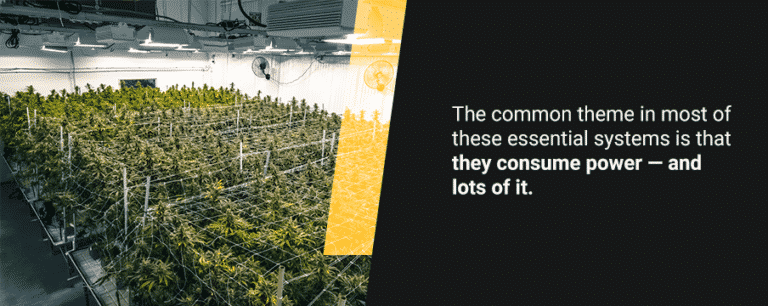
Choosing an adequately-sized backup generator is essential, as it needs to be able to run all your critical systems. You’ll need about 1,000 amps for every 10,000 square feet of space. As an alternative to one large generator, you can create an even more robust backup system by running multiple smaller generators in parallel. Running generators in parallel allows for lower maintenance costs and fuel consumption while providing even greater peace of mind when it comes to your cannabis crop.
Backup generators are often an afterthought for commercial cannabis growers, but they should be considered a part of your initial investment. Operating a commercial grow room without backup power is essentially inviting disaster. It can take just a few hours of downtime for your carefully-built growing environment to suffer catastrophic destabilization that will wipe out your profits. Don’t go without the ability to keep your plants stable and happy in the event of a power outage.
Grow Room Checklist
What else do commercial cannabis growers need to ensure success? Once you’ve set up the systems above, turn your attention to these items to complete your commercial grow room.
- Cleaning supplies to ensure you maintain cleanliness and pass health inspections
- Antibacterial wash stations to protect employees and plants
- Personal safety protection such as protective hats and sunglasses for UV light, and respirators if you are using pesticides
- Equipment to measure pH and total dissolved solids (TDS) to ensure optimal growth conditions
- Trimming equipment to prevent bottlenecks in the harvesting process
- Carbon filters to minimize smell from your operation
- Reflective film and liners to maximize light
- Floor fans to promote optimal air circulation
- Drying racks for the curing process
- Storage receptacles for harvested material
With these supplies, in addition to dependable systems and backup power for your grow room, you can grow high-quality commercial cannabis all year long.
Generate Commercial Cannabis Profits With Woodstock Power
When you’re selecting a backup generator for your commercial grow room, you need a supplier you can trust. Woodstock Power is your partner in finding the optimal power solutions for your commercial applications, and we can help you find the right generator or parallel generator system for your cannabis grow room. We’re with you from choosing your generator to delivering and installing it.
All Woodstock Power generators undergo testing, so you know you’re getting a dependable supply of power ready when you need it. To learn more about our services, give us a call at (610) 658-3242 or get in contact online.
Follow us on LinkedIn, YouTube, Facebook, and Twitter for more info about commercial generators!


